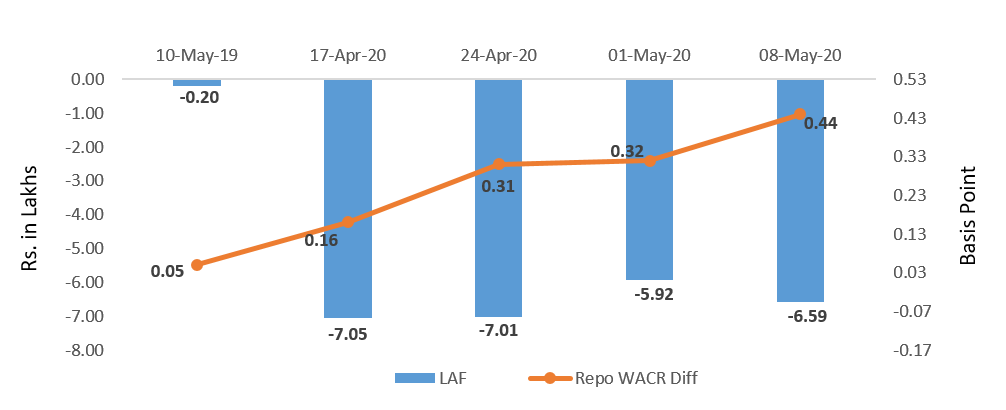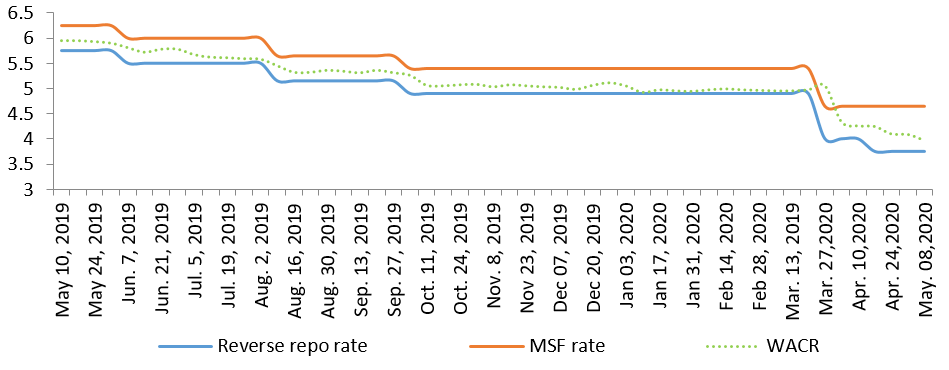The rate cut of 40 bps was a fundamental requirement and did not come as a surprise. It is noted that the systemic liquidity was not the primary concern behind the move as it remains more than adequate. Instead, the motive was to further reduce the cost of capital so that corporations are not bogged down by prohibitive interest rate obligations during these difficult times. Apart from signalling monetary accommodation, the Repo must also reflects the reality that the rate of interest must be lower than the rate of GDP growth. Since FY21 will record a contraction in real terms, the best possible scenario for nominal expansion is around 4-5%. The reduction in Repo today brings us in that ballpark.
The adequate systemic liquidity however is largely driven by a suboptimal credit offtake, which at 6.73% is at an all-time low. Deposit growth rate on the other hand is recording a healthy 9.85%, which is similar to normal circumstances. It is noted by the MPC itself that investments of commercial banks in debt securities has increased by over Rs. 0.66 lac crore already, given the availability of excess cash. Therefore, we do not see any significant impact on commercial bank financials due to the extension of moratorium by 3 months (announced today), apart from net interest income. It is doubtful whether they will be under some kind of pressure going forward also because the moratorium does not impact the entire exposure. Moreover, we believe that the current situation will aid the Liquidity Coverage Ratio (LCR) of most commercial banks, given the rise in their HQLA holdings and lower redemption/ net outflow pressures. The RBI on its part has pumped in significant liquidity through various mechanisms and is now busy sterilizing the system.
Liquidity Operation by RBI:

Source: RBI, Acuité Research;
Note: Net injection (+) and Net absorption (-)
Nevertheless, the rise in the NPA situation is a definite possibility and taking stock once the crises is over will be too late. A one-time loan restructuring of stressed sectors/ entities is the need of the hour. Commercial banks will remain sceptical in taking hair-cuts at this time and may look at the Government for bailouts. Nevertheless, since the fiscal space for such an activity is limited at this time, we propose a solution via the creation of a bad bank (under PPP mode) on the lines of the American TARP fund.
While we do not see any significant declines in the deposit rate, we are nonetheless worried about the off take number, which must be revived and sustained during this time. Transmission on the ground remains a concern but the relatively high marginal cost of borrowing for banks is a major hurdle here. The trouble is that banks have be competitive vis-à-vis small savings schemes, which are in turn, not driven by market realities. The RBI on its part has done its job and has already communicated its intent regarding ‘whatever it takes to revive the economy’. Nevertheless, the Repo decision has to consider other market factors such as call money rate, 2 year GSec yields and the RBI’s net domestic and foreign asset holdings. For the rate to therefore go down further, all other independent factors must be considered holistically.
What to expect next?
Going forward, we believe that reviving consumption will be the key as it has been largely ignored, until now. Generally, direct pay-outs, interest concession and tax rebates play an important role in building confidence among households as extra money in hand is often used in consumption. Reviving the demand side is therefore critical.
We are expecting the economy to contract by over (-) 1% in FY21 in real terms. This contraction could be more debilitating if the lockdown in its current form continues beyond May end. All hopes are on pent up demand, which should come back with a vengeance and help the market in a V-shape recovery. But this assumption is dependent on when the lockdown is lifted and normalcy is restored. Having said that, H2 (FY21) onwards, we could see a strong revival. Concerns on inflation are real though as crude prices strengthen. Also, despite healthy crop output, supply disruptions will continue to exert pressure on prices, as echoed by the MPC today in its statement.
Policy Corridor and WACR

Source: RBI, Acuité Research